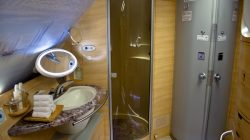One of my favorite parts of collecting miles is redeeming them for flights on special aircraft. Although the Boeing 747 has lots of flaws, it’s still the original “jumbo jet” and offers a unique travel experience in first class, whether you’re in the more private upper cabin or downstairs in the nose with the ability to look forward out the window. I was on one of Cathay Pacific’s last 747s between Hong Kong and San Francisco and put up a stink when they tried to move me out of seat 1K.
But most people are interested in the new kids on the block. The Boeing 787 Dreamliner (for its innovative use of new technologies) and the Airbus A380 (for its enormous size) are two of the most popular. I expect we’ll soon be seeing people ask where the Airbus A350XWB flies, too.
Finding Which Aircraft Fly Which Routes
It’s not difficult to identify the aircraft on a specific route. Most websites will share that information while booking. In a pinch, you can enter the flight number and date in SeatGuru (and pick a good seat assignment while you’re at it). But if you don’t care about the route — just the plane — then it’s a little trickier.
Boeing and Airbus each have promotional websites dedicated to these aircraft that purport to share all the routes they fly. I think Boeing’s 787 website is superior in that it makes it easier to filter by different airlines or cities. I would prefer that it just show a map with all the lines crisscrossing the globe, but I haven’t found any authoritative source that does this. (You may still find some less authoritative hobbyists who create their own maps, such as this A380 map on FlightDiary. Just do a Google search.) Boeing also displays all the different planes currently in the air, though I don’t think this visual clutter is actually helpful.
The Airbus A380 website has its own pluses. You can’t see all the routes at once, but you can click on individual departure cities and see those routes drawn on the map. Unlike Boeing’s site it does not update with realtime information on current flights.
Using either tool requires some exploration. I think the best approach is to filter by or click on the city you want to visit or depart from. Living in Seattle I’d probably explore some nearby West Coast cities, although I could also look at a few options in the country (or continent) I want to visit. Just be aware that the information isn’t totally accurate. Boeing has three entries for Seattle, two of which list flights by Qatar Airways and China Southern. But neither one operates any flights to Seattle. Only the third, Hainan Airways, is for real, operating the 787 on its route to Beijing.
Finally, some die-hard industry and hobbyist sites will display all the routes, including flight numbers and schedules, in list form. Unfortunately I think it’s more information than is necessary and not in the most helpful format for this purpose. Examples include this blog on All Things 787 and these updates from Routes Online for the 787 and the A380.
Booking Travel on a Special Aircraft
When you find a flight you actually want to book, it could be easier than you think to use miles for an award. From an economic standpoint, the 787 is designed for routes that can’t support traditional long-haul aircraft like the Boeing 777. In other words, there’s low demand. Individual routes may have their own reasons for success or failure, but I routinely see award space available on some 787 routes such as United’s flight from San Francisco to Chengdu. Don’t want to go to Chengdu? You can connect onwards.
A slightly different argument can be made for flights operated by the A380. The thing is enormous! It works well in markets that either have huge demand or offer limited landing slots, where one daily flight might make more sense than two. On the other hand, flying such a large plane creates an abundance of supply. Asiana has an A380 on its route from Los Angeles to Seoul that regularly has two or more seats in business class every day of the week. Asiana isn’t normally stingy with award space, but that’s still pretty good by any standard.
Finally, you can take advantage of so-called Fifth Freedom routes. Amol previously described these very well and provided a list of some examples. In a nutshell, they’re short flights that continue from other, longer flights. Because of this they aren’t restricted by the usual trade barriers erected to protect domestic flag carriers, and they can be a less expensive way to try out a long-haul aircraft on what would otherwise be a short- or medium-haul route. One example is the Emirates A380 flying between Bangkok and Hong Kong.
What are your favorite ways to find and book travel on a “special” aircraft?




